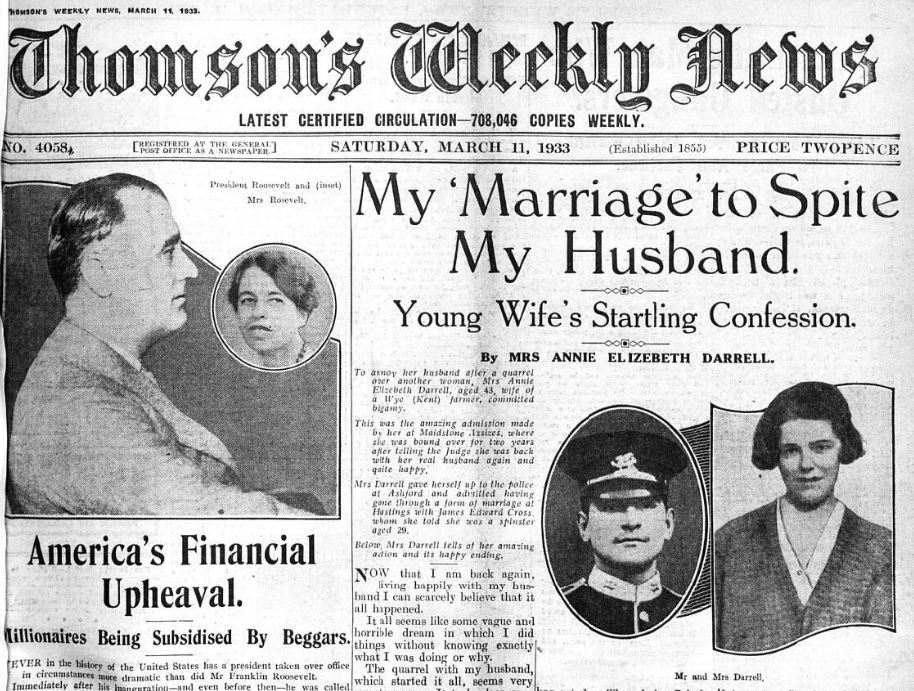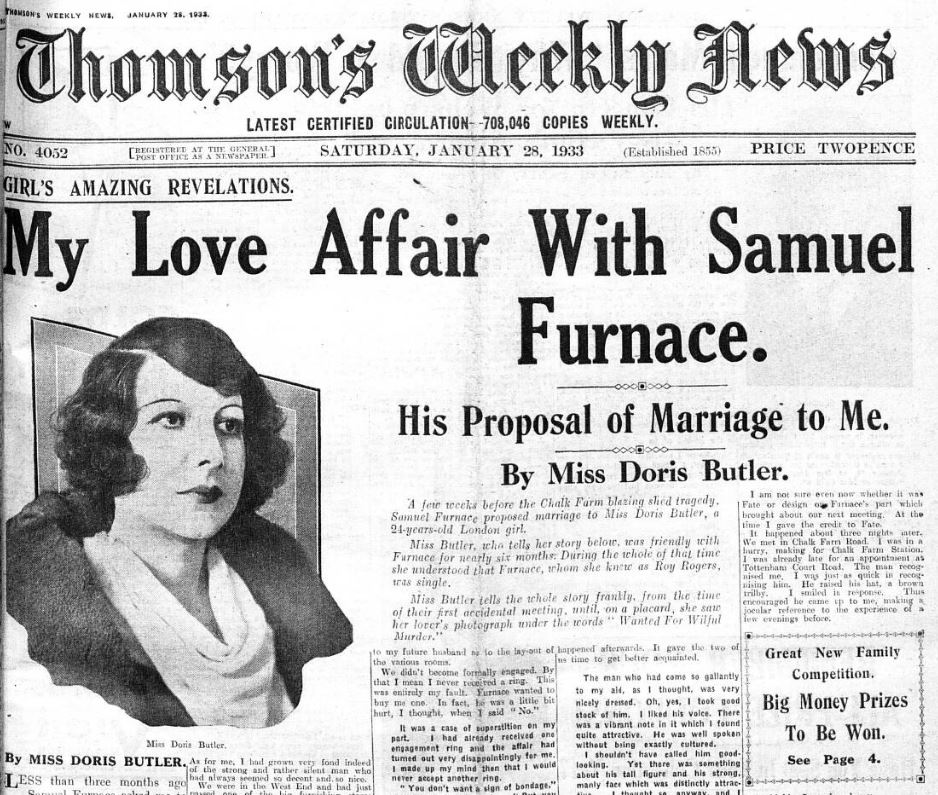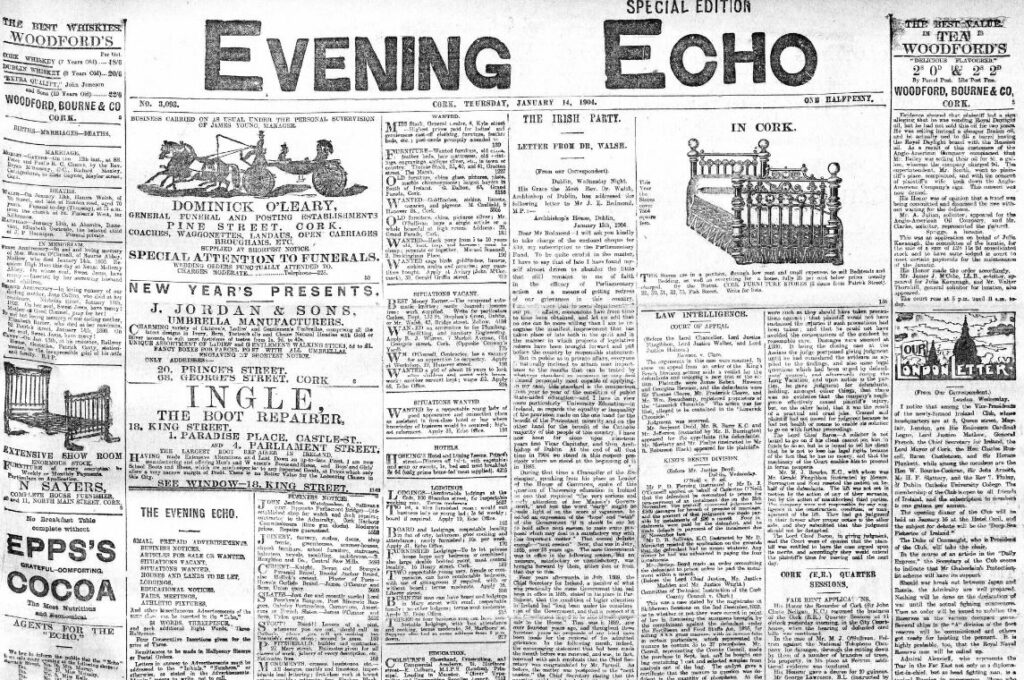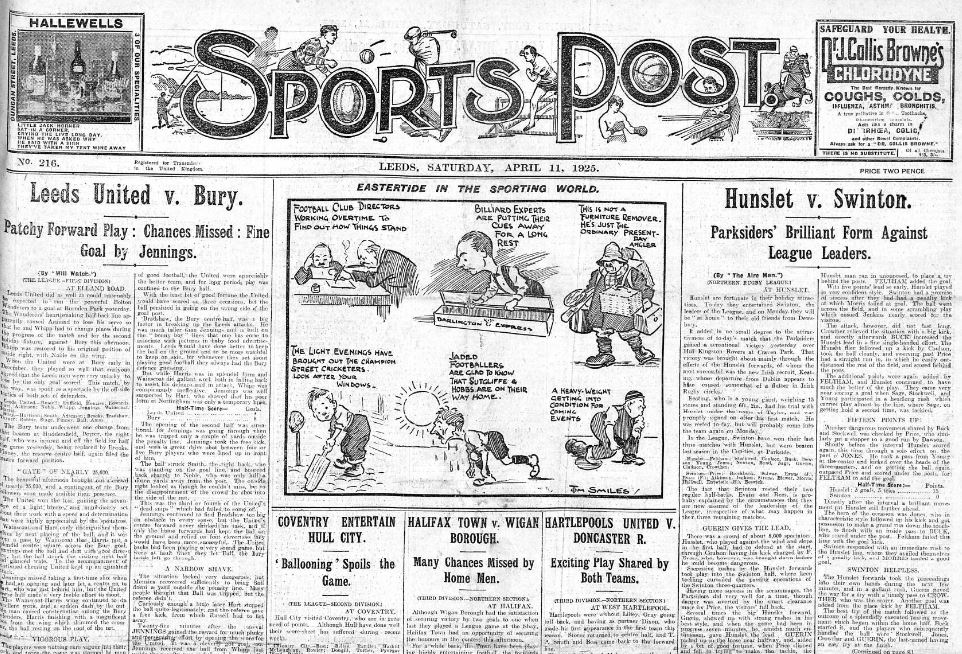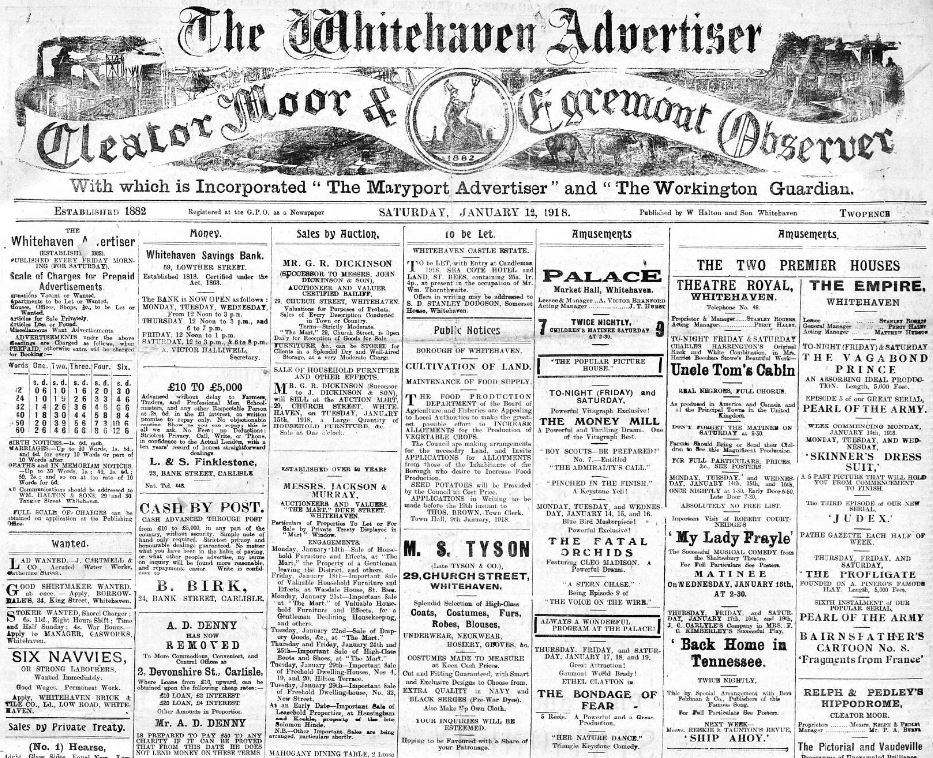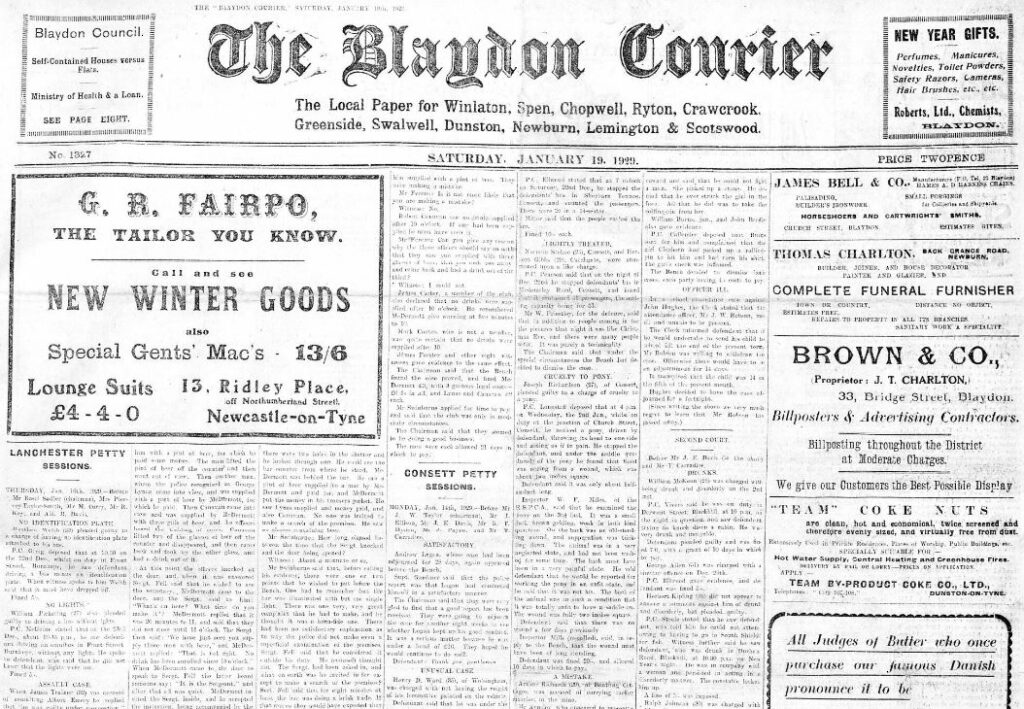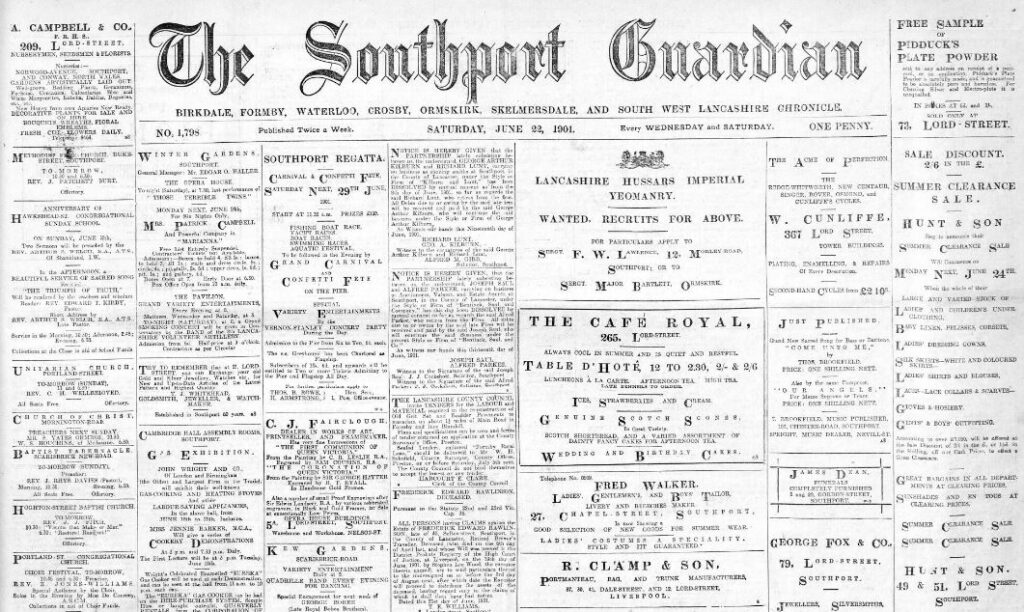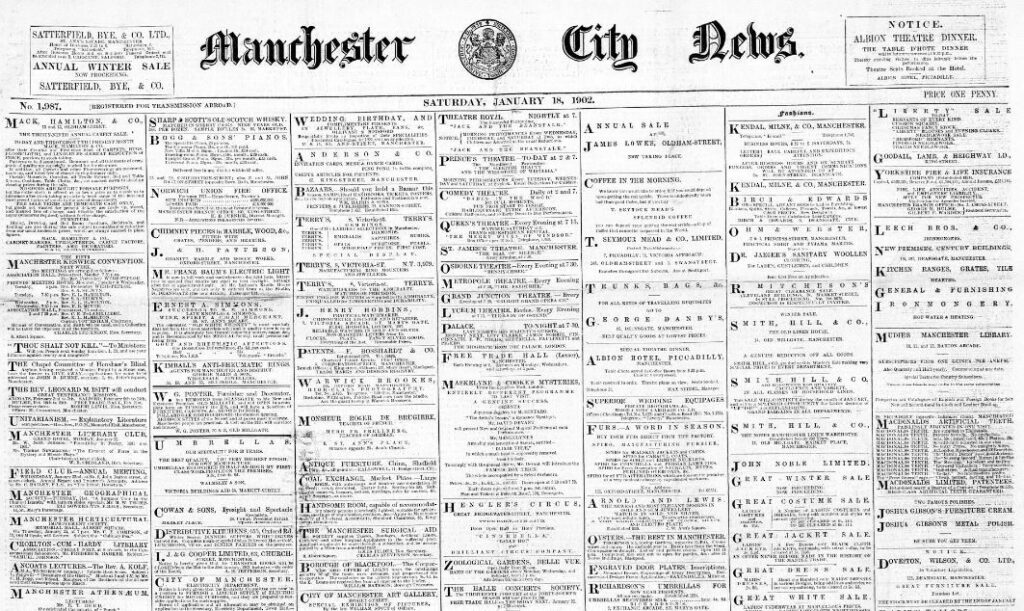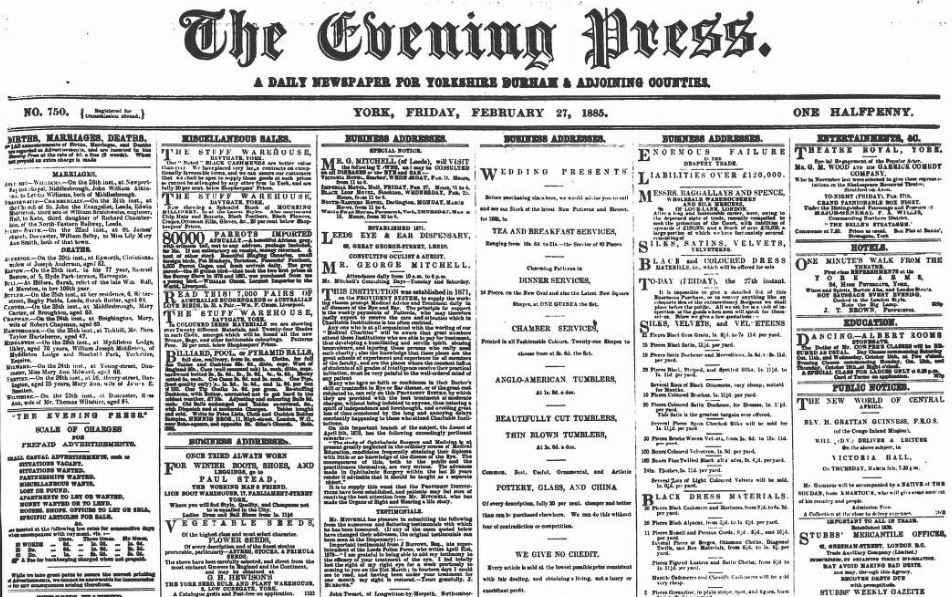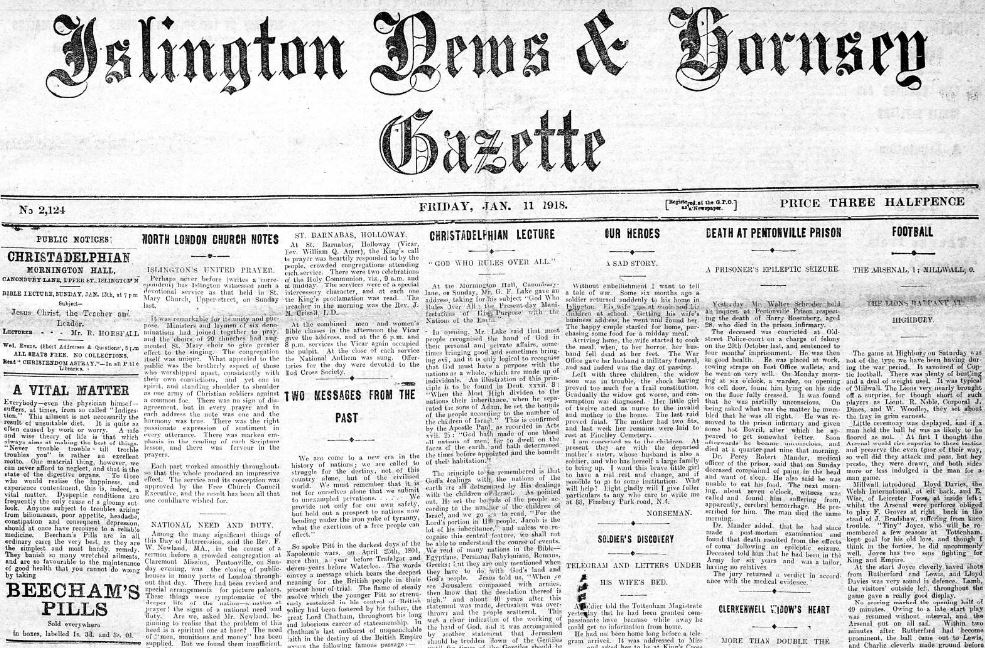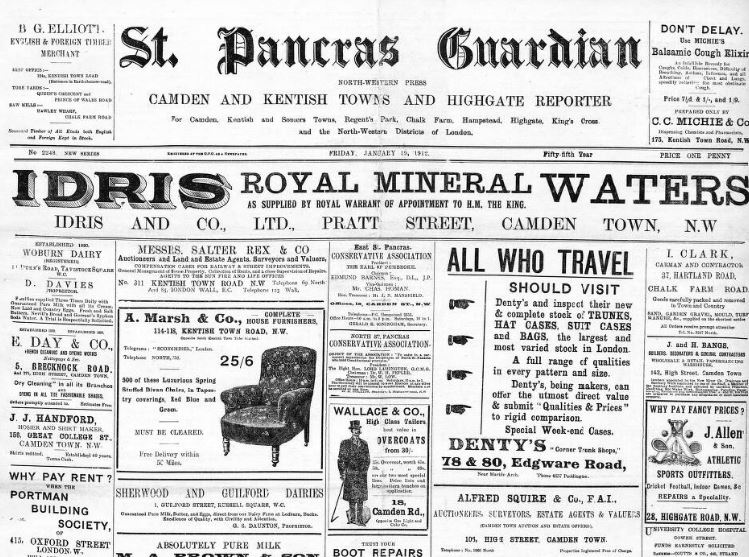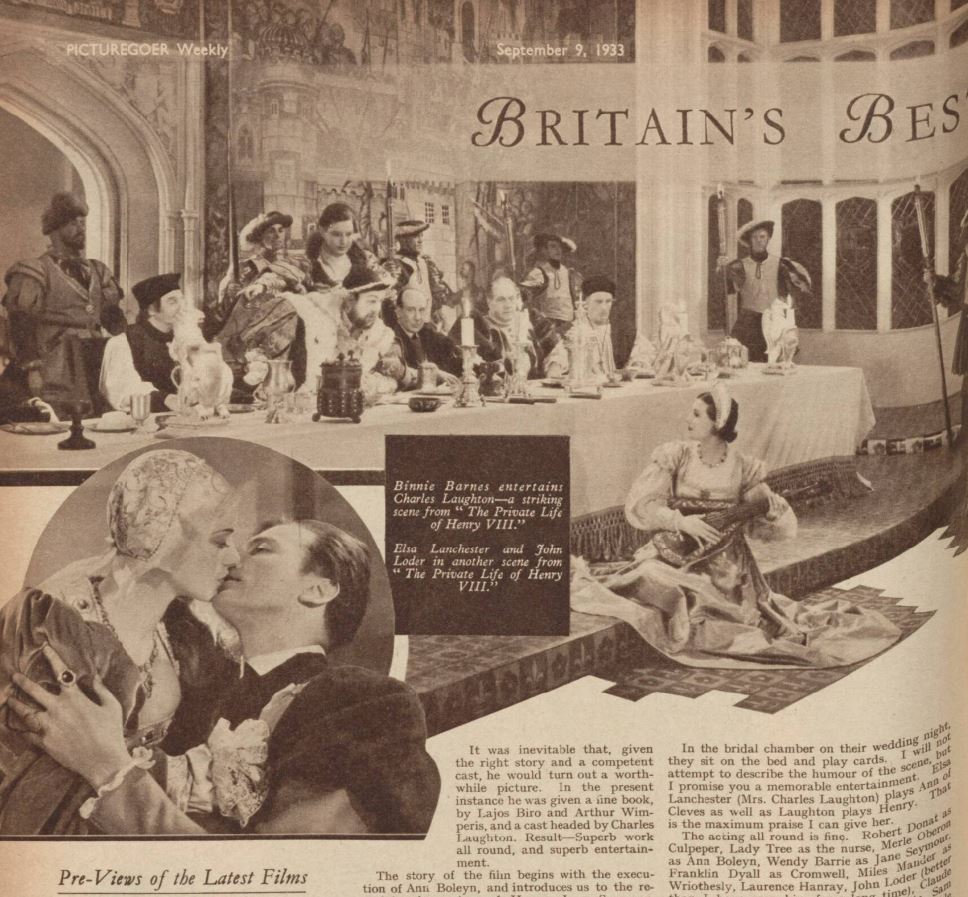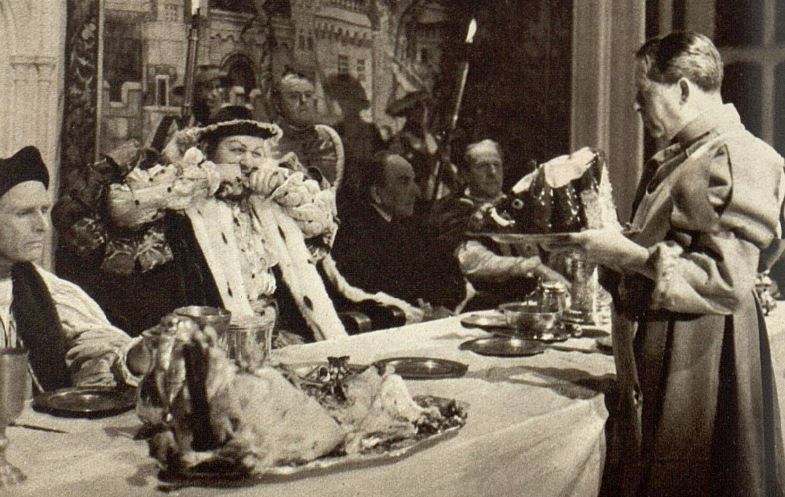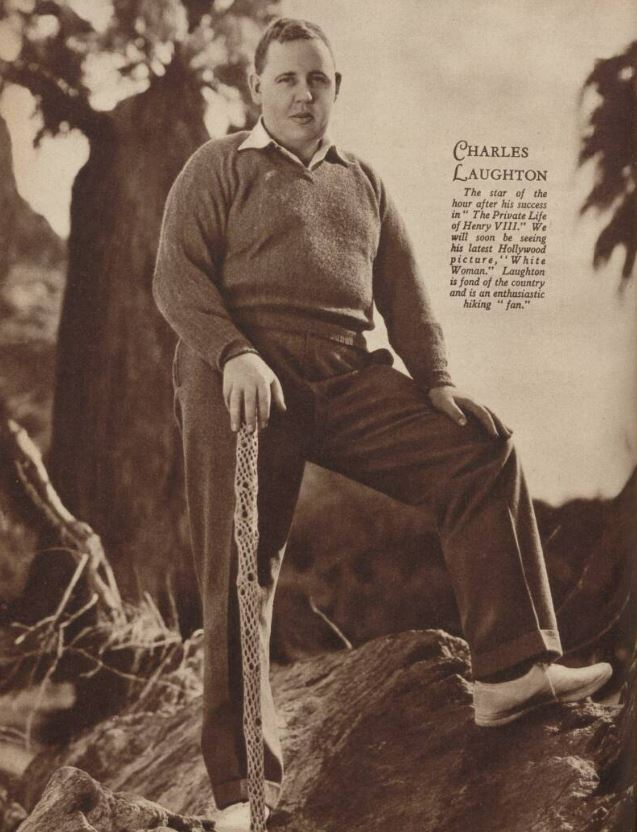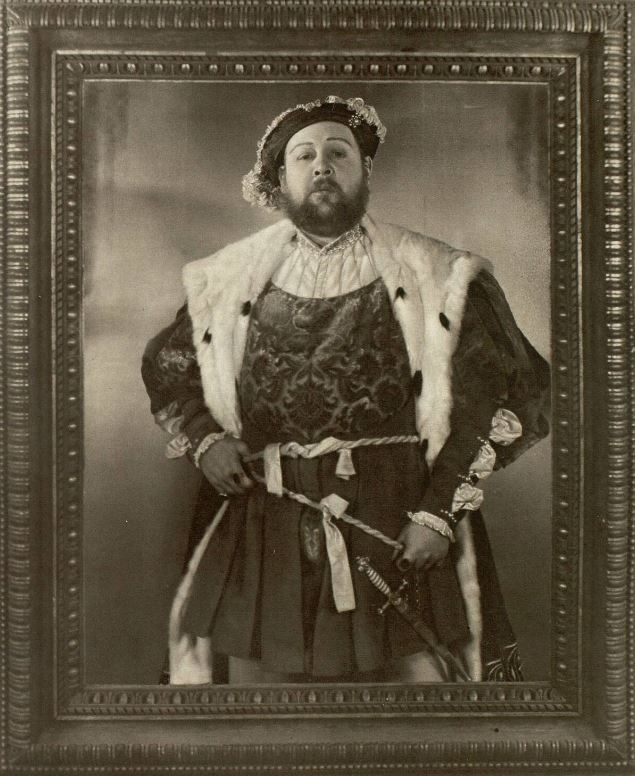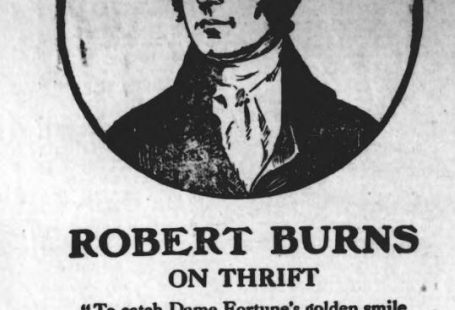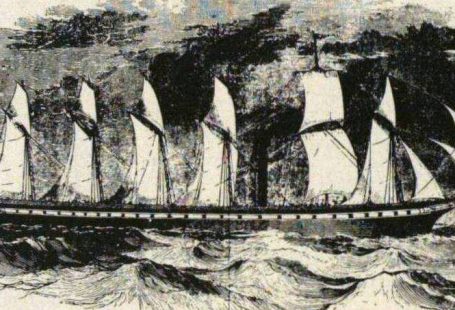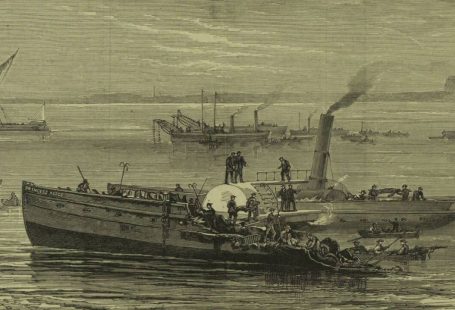This week at The Archive we have been busy adding a staggering 706,009 brand new newspaper pages, including the addition of best-selling Scottish newspaper Thomson’s Weekly News and some specialist sporting titles. We’ve added eleven brand new titles to our collection in all this week, with new titles joining us from Cork, Cumbria and Camden. Meanwhile, from Accrington to Aldershot, from Dorking to Dorset, from Ealing to East Kilbride, we’ve updated 82 of our existing titles from across the United Kingdom and Ireland.
So read on to find out all about our new and updated titles of the week, as well as to find out about the best British film of ninety years ago – The Private Life of Henry VIII – and its Oscar-winning star Charles Laughton.
Register now and explore the Archive
We begin our journey through our new titles of the week in Scotland, specifically in Dundee, with Thomson’s Weekly News, which was first published on 12 May 1855. This newspaper was born out of the need for a Saturday publication for the working classes, a need that was identified by Robert Park, who would go on to found Dundee’s first daily newspaper, the Daily Argus, in 1859.
Furthermore, Dundee newspaper the Northern Warder decided to publish a Saturday edition of its newspaper, dedicated to the Crimean war, and hence, the Weekly News was born. Dubbed a ‘national miscellany news-sheet,’ printed for working people and artisans, this Saturday edition of the Northern Warder became the first penny weekly paper in Scotland, consisting of ten to twelve pages.
In 1886 control of the Weekly News passed to publishers W. & D.C. Thomson, alongside fellow Dundee title the Dundee Courier, and under brothers David Couper and Frederick Thomson, circulation of the publication grew. Beginning with a circulation of 60,000 copies in 1886, by the end of the 1880s 100,000 copies were being sold every week, with this number rising to 250,000 copies by the mid 1890s and to 300,000 copies by 1911.
Furthermore, in 1890 the Weekly News published eleven different editions, serving Dundee City, Aberdeen City, the Northern Counties (of Scotland), Perthshire, Fife & Kinross-shire, Stirling District, Edinburgh & South, Glasgow & West, Forfarshire, the North of England and the North of Ireland. Before too long, the Weekly News was being advertised as the biggest selling paper in Scotland and the biggest-selling newspaper outside of London, as it was circulated to all parts of the British Isles.
By the 1970s, and now known as Thomson’s Weekly News, the title was believed to sell over one million copies per week. It led the way in interviewing the biggest stars of the day, featuring human interest stories, with a focus on all things celebrity and intrigue.
This week we’ve published the year 1933 from Thomson’s Weekly News. By this point in the publication’s lifespan it filled 28 pages, with stories fuelled by gossip and intrigue, with headlines like ‘Secret Behind Death of Beautiful Dancer’ and ‘Couple’s All-Night Dash to Gretna,’ sitting alongside glossy photographs. Thomson’s Weekly News also featured real life stories like ‘Married Woman Finds Love Too Late’ and ‘Man’s Dread at Losing Invalid Wife,’ as well as domestic advice, fashion wisdom, short stories and sporting news.
The final edition of this best-selling and iconic title appeared on 30 May 2020.
From Scotland now to Cork, and the Evening Echo, which was first published in broadsheet form in 1892. It was launched as an evening newspaper by proprietor of sister Cork paper the Cork Examiner, Thomas Crosbie, and the publication remained in the hands of the Crosbie family until the 21st century.
Distributed throughout the province of Munster, although mainly read in Cork, this newspaper had a long association with the ‘Echo Boys,’ poor and often homeless children who sold the newspaper throughout the city.
By the 1910s, the Evening Echo cost one halfpenny, and filled six pages. Its focus was on national and international news, which sat alongside sporting and commercial news, and notices of births, marriages and deaths. In 1991 the Evening Echo switched to a tabloid form, and by this point in time, its focus had switched to cover more local news. In March 2019 the newspaper was rebranded as The Echo, becoming a morning newspaper, and is still published to this day.
We’re going to travel back across the Irish Sea now to introduce a duo of new sporting titles that have joined The Archive this week, kicking off with the Football Echo (Sunderland). Launched on 7 September 1907 as part of the Sunderland Daily Echo and Shipping Gazette, this football-focused newspaper appeared every Saturday. By the the 1950s, the Football Echo featured a wonderful masthead, and cost all of two pence.
As might be expected, the newspaper’s focus was on local team Sunderland A.F.C., but the newspaper also took a look at football across the country, reporting on F.A. Cup matches, the different English divisions, as well as the Scottish leagues, and local leagues like the Wearside League and the North-Eastern League. The Football Echo, meanwhile, also took a look at other sports such as tennis, rugby, and horse racing, as well as featuring cartoons and correspondence from readers.
Our other new sporting title of the week also hails from the north of England, and is the Sports Post (Leeds), which was founded in 1919 as an offshoot of Leeds-based regional newspaper the Yorkshire Evening Post. Originally only published in the football season, the Sports Post appeared every Saturday at the cost of two pence, and filled eight pages.
Like the Football Echo, the Sports Post focussed on its local football team Leeds United, but also covered other sports like cricket, rugby, boxing, fishing and even billiards. This fun and lively publication featured photographs and cartoons, as well as a look at the day’s fixtures, and also reported on other local football teams like Keighley, Huddersfield Town, and Hull.
We travel from Leeds now to Whitehaven, a town and port which historically was a part of Cumberland, to introduce the Whitehaven Advertiser and Cleator Moor and Egremont Observer. Founded in 1882 as a an independent publication, before adopting a more Conservative stance, the Whitehaven Advertiser incorporated the Maryport Advertiser and the Workington Guardian.
Appearing every Saturday, the Whitehaven Advertiser had a particular focus on agriculture, reporting on the local markets and the price of produce like butter. Filling eight pages, this publication contained a wealth of local news, with reports on Whitehaven organisations like Whitehaven Ladies Association Football Club and the United Methodist Church. It featured lengthy descriptions of local marriages, as well as the local ‘amusements’ on offer in the area.
Meanwhile, the Whitehaven Advertiser reported on the latest from the local police courts, from the courts of Whitehaven, Maryport, Cockermouth and Barrow. Beyond Whitehaven, it provided the news from Cleator Moor, St. Bees, Seascale and Egremont, featuring the latest from the Cumberland Quarter Sessions. The newspaper contained sporting news, and a special ‘Ladies’ Letter.’
We’re at the halfway point of our new titles this week, and we travel to the east side of the country to welcome the Blaydon Courier to our collection. Founded in 1905 as part of the Consett Guardian series of newspapers, the Blaydon Courier was politically independent and appeared every Saturday in the town of Blaydon, which is now in Gateshead, but was historically a part of County Durham.
Dubbing itself as the ‘The Local Paper for Winlaton, Spen, Chopwell, Ryton, Crawcrook, Greenside, Swalwell, Dunston, Newburn, Lemington & Scotswood,’ the Blaydon Courier was filled to the brim with local news, reporting from the Lanchester and Consett Petty Sessions, and the Gateshead County Police Court. It reported on local weddings and whist drives, with features like ‘Stanley’s Oldest Inhabitant,’ as well as featuring serialised fiction, notices of births, marriages and deaths, and reports on sports like football and rugby.
We are criss-crossing the country this week as we run down our list of new titles, and we now arrive in Merseyside to introduce the Southport Guardian. Historically a part of Lancashire, the seaside town of Southport was founded in 1792 when innkeeper William Sutton built a bathing house at the south end of Lord Street. Fast-forward into the nineteenth century, the town became popular with tourists from Liverpool and Leeds, given its proximity to the two cities.
As for the Southport Guardian, it was established in 1881 as a Liberal newspaper, with the full name of the Southport Guardian, Birkdale, Formby, Waterloo, Crosby, Ormskirk, Skelmersdale, and South West Lancashire Chronicle. In 1885 the newspaper was enlarged, appearing every Wednesday and Saturday at the cost of one penny, and filling an impressive twelve pages.
Costing just one penny, the Southport Guardian circulated ‘throughout the Southport and Ormskirk parliamentary divisions of South-west Lancashire.’ A thorough local newspaper, it featured local news from institutions like the High Park Independent Methodists, the YMCA Mission and the Marshside Sunday School. It published ‘police intelligence’ from Southport, as well as district news from Ormskirk, as well as lists of visitors to the town.
Looking beyond Southport, the publication also contained ‘the latest news’ from the rest of the country and beyond, but its focus was definitely on the local, as it featured reports on local funerals and sports, like football, golf, athletics and shooting. The Southport Guardian, meanwhile, published a column entitled ‘Concerning Women,’ as well as special children’s section headed ‘For Young Folks.’ It was last published in 1953.
Our next new title of the week hails from Manchester, and is the Manchester City News, which first appeared on 2 January 1864. A weekly local newspaper, it circulated in Manchester, Salford, and towns in the counties of Lancashire and Cheshire, dubbing itself ‘the local intelligencer of the city and district.’ Appearing every Saturday, by 1871 the newspaper’s fortunes were flagging, but they were soon turned around by the appointment of journalist and linguistic John Howard Nodal (1831-1909) as editor.
John Howard Nodal had a particular interest in science, literature and language, especially within the local Manchester area. To this end, he introduced sections to his newspaper like ‘Outdoor Notes: A Journal of Natural History and Out-Door Observation,’ which he himself penned. And so by the late 1880s the Manchester City News was known as the ‘leading literary and artistic journal’ in Manchester, featuring ‘columns of notes and queries and of country notes, reports of the learned societies, and essays and papers by the most eminent local authors &c.’
By the turn of the century, the Manchester City News cost one penny and filled eight pages. Its devotion to all things natural history was reflected in articles headed ‘Bird Notes’ and ‘Life in a Pond,’ whilst the newspaper also incorporated pieces on literature, art, artists, music and drama. Indeed, the Manchester City News at this time could be said to be more of a journal than a newspaper, although the publication did feature commercial news, the latest from the city’s churches, the weather news, news from the city’s guardians, and notices of births, marriages and deaths.
John Howard Nodal remained editor of the Manchester City News until 1904. On 28 August 1936 the publication changed its title to the City News, returning to its original title from 13 November 1937 to 29 April 1955 when it was again renamed, this time to the City & Suburban News. After this time, the title changed variously to the Lancashire County Express, the County Express and the Manchester County Express, before finally ceasing publication in 1963.
We travel into the neighbouring county of Yorkshire now to welcome our next new title of the week, which is the Yorkshire Evening News. This newspaper was founded in Leeds in 1872, and it was an alternative evening newspaper to the Yorkshire Evening Post. Costing one halfpenny, and filling eight pages, by the 1910s this title was an attractively organised publication, featuring photographs, cartoons and lively short bulletins of both local and national news.
The Yorkshire Evening News, meanwhile, took a look at domestic matters in its ‘Cosy Corner Chat,’ which answered ‘house and home questions’ (but not cookery queries). It also looked at the local employment situation, with a column entitled ‘The World of Labour’ and reported on strikes in the area. Finally, the publication published sporting news, with reports from football and cricket matches, as well as billiard games, which were accompanied by diagrams. The Yorkshire Evening News ran until 1963.
We’re going south now for our penultimate new title of the week, which is the charming local London paper the Islington News and Hornsey Gazette. Founded in 1877, this initially Liberal newspaper gave ‘full reports of local meetings and events of interest to this extensive parish.’ By the late 1880s, the Islington News had switched to an independent viewpoint, appearing every Friday at the cost of three halfpence.
Filling six pages, the Islington News reported on all the happenings in North London, with headlines like ‘Holloway Pensioner Fined,’ ‘Shop Lifting at Kingsland,’ and ‘Holloway Nurse Falls Downstairs.’ Meanwhile, the newspaper detailed the latest news from the Islington and Holborn Guardians, the Finsbury Council, and churches in the area. It did contain some international and national news, but the Islington News’s focus was on all things local, with reports on the local football teams, and ‘Notes from the Islington Bells.’
Our final new newspaper title of the week is another North London title, and it is the St. Pancras Guardian and Camden and Kentish Town Reporter. Circulating ‘in St. Pancras, Kentish Town, and Holborn, and in the Northern suburbs of London,’ this Liberal newspaper was established in 1869 and was ‘The Official Organ for Camden Town, Kentish Town, Regent’s Park, Chalk Farm, Hampstead, Highgate, King’s Cross, Euston Road, and the North-Western Districts of London.’
Appearing every Saturday, and costing one penny, the St. Pancras Guardian filled eight pages and contained both local, national and international news. On the local front, it reported on the latest from instutitions like the St. Pancras Guardians, the Bedford Chapel, the Goldington Crescent Temperance Society and the Clerkenwell County Court. The publication also featured reports on inquests in St. Pancras, as well as articles on local funerals and charities. Meanwhile, the St. Pancras Guardian also featured ‘Bits from Books’ and serialised fiction.
That’s it from our eleven brand new titles of the week. But before we move on to take a look at Charles Laughton’s award-winning turn in a film from ninety years ago, we thought we’d highlight some of our updated titles of the week. Our updates hail from across the United Kingdom and Ireland, with new pages joining Dublin’s Evening Herald, as well as Scottish newspapers the Irvine Herald and the Lanark & Carluke Advertiser and Welsh newspapers the Rhondda Leader and the Rhyl, Prestatyn Visitor.
Other highlights include the over 160,000 brand new pages we have added to the Lincolnshire Echo, and the over 120,000 brand new pages we’ve added to the Hull Daily Mail. Meanwhile, this week sees other significant updates to the South Wales Echo, the Birmingham Daily Post and the Birmingham Mail.
A Film from Ninety Years Ago – A Look at Charles Laughton in The Private Life of Henry VIII
On 9 September 1933 our new title Thomson’s Weekly News featured a photograph of Charles Laughton in new film The Private Life of Henry VIII, writing how ‘we have heard so much about him.’ The caption goes on to describe how Laughton (1899-1962), who was born in Scarborough, ‘excels in this star role.’
Meanwhile, recently added pages to film fan magazine the Picturegoer shed more light on Laughton’s performance, which would win him the Academy Award for Best Actor in 1934. Indeed, the film he starred in was the first ‘foreign’ film to receive a nomination for Best Picture.
On 9 September 1933 the Picturegoer provided some ‘Pre-Views of the Latest Films,’ which included a look at The Private Life of Henry VIII. The reviewer raved over the British-produced film, which was directed by Hungarian-British director Alexandar Korda, stating how it was ‘the finest picture we have turned out in our studios.’
The reviewer outlines the plot of the film, describing how:
The story of the film begins with the execution of Ann Boleyn, and introduces us to the remaining four wives of Henry – Jane Seymour, Ann of Cleves, Katheryn Howard, and Katherine Parr. Each has her story and every story is part of the whole – the story of Henry VIII. You watch him grow old and feeble until you say farewell to the henpecked husband who does exactly what he is told.
Then, the ‘tremendous’ performance of the film’s star, Charles Laughton, is outlined as follows:
Charles Laughton is tremendous as Henry. From the moment he appears he dominates everybody and everything, but he does not dwarf them. You might, with reason, say it is one-man picture, yet you could not say that the other characters are out of perspective.
The Picturegoer piece continues:
How Laughton must have revelled in the part! You see him as a cruel, vindictive, jealous husband, as a doting father, as a statesmanlike king, as a vain, vulgar, boastful man, as a feeble dotard. At the special showing I attended, there was a round of applause for a close-up showing Laughton’s face when his last wife Katherine Parr orders him to stop eating and drinking. That look was more eloquent than a volume of words.
An unusual part of the production was that Laughton’s actual wife, actress Elsa Lanchester, appeared as his on-screen wife Anne of Cleves. The same Picturegoer preview remarks how Lanchester ‘plays Ann of Cleves as well as Laughton plays Henry.’
Some months before, meanwhile, Picturegoer writer E.G. Cousins went on set at Elstree to take a peek behind the scenes of the production. Cousins’s piece was published on 10 June 1933, and it described Laughton’s first film appearance as a ‘drunken diner’ in Piccadilly only a few years before. Since then, Cousins writes, he had been to Hollywood and ‘achieved international fame,’ but had returned to England ‘for a fraction’ of the salary he could expect in America to shoot The Private Life of Henry VIII.
Cousins was beyond impressed with what he witnessed on the Elstree set, describing how when Laughton:
…put King Henry’s plumed beret on his head – [he] immediately became the king. He seemed to grow in stature; he didn’t need the sparse red beard by which the eighth of our Henrys is known. Ladies and gentlemen, here is truly that very rare thing, which occurs once or twice in a generation – an actor; just as Flora Robson is an actress. Korda is wise in engaging his services, instead of saddling himself with an American with a ‘big star name,’ totally unsuited to the part.
And the rest of the world too was impressed with what they saw. Charles Laughton became the second British actor to win the Academy Award for Best Actor in 1934, following on from inaugural British winner George Arliss. Laughton’s win marked a milestone at the Academy Awards, as he was the first actor to win the award for a ‘foreign’ film.
New Titles
| Title | Years Added |
| Blaydon Courier | 1929 |
| Evening Echo (Cork) | 1904, 1909, 1914 |
| Football Echo (Sunderland) | 1956 |
| Islington News and Hornsey Gazette | 1918 |
| Manchester City News | 1901-1902, 1904, 1906, 1910, 1914, 1937 |
| Southport Guardian | 1901, 1906, 1921 |
| Sports Post (Leeds) | 1925 |
| St. Pancras Guardian and Camden and Kentish Towns Reporter | 1881, 1908, 1910, 1912, 1918 |
| Thomson’s Weekly News | 1933 |
| Whitehaven Advertiser and Cleator Moor and Egremont Observer | 1918 |
| Yorkshire Evening News | 1907, 1914 |
Updated Titles
This week we have updated 82 of our existing titles.
You can learn more about each of the titles we add to every week by clicking on their names. On each paper’s title page, you can read a FREE sample issue, learn more about our current holdings, and our plans for digitisation.
You can keep up to date with all the latest additions by visiting the recently added page. You can even look ahead to see what we’re going to add tomorrow.


